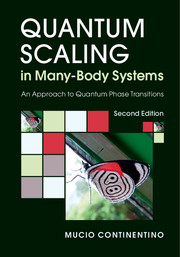Book contents
- Frontmatter
- Dedication
- Contents
- Preface
- 1 Scaling Theory of Quantum Critical Phenomena
- 2 Landau and Gaussian Theories
- 3 Real Space Renormalisation Group Approach
- 4 Renormalisation Group: the ∊-Expansion
- 5 Quantum Phase Transitions
- 6 Heavy Fermions
- 7 A Microscopic Model for Heavy Fermions
- 8 Metal and Superfluid–Insulator Transitions
- 9 Density-Driven Metal–Insulator Transitions
- 10 Mott Transitions
- 11 The Non-Linear Sigma Model
- 12 Superconductor Quantum Critical Points
- 13 Topological Quantum Phase Transitions
- 14 Fluctuation-Induced Quantum Phase Transitions
- 15 Scaling Theory of First-Order Quantum Phase Transitions
- Appendix
- References
- Index
6 - Heavy Fermions
Published online by Cambridge University Press: 04 May 2017
- Frontmatter
- Dedication
- Contents
- Preface
- 1 Scaling Theory of Quantum Critical Phenomena
- 2 Landau and Gaussian Theories
- 3 Real Space Renormalisation Group Approach
- 4 Renormalisation Group: the ∊-Expansion
- 5 Quantum Phase Transitions
- 6 Heavy Fermions
- 7 A Microscopic Model for Heavy Fermions
- 8 Metal and Superfluid–Insulator Transitions
- 9 Density-Driven Metal–Insulator Transitions
- 10 Mott Transitions
- 11 The Non-Linear Sigma Model
- 12 Superconductor Quantum Critical Points
- 13 Topological Quantum Phase Transitions
- 14 Fluctuation-Induced Quantum Phase Transitions
- 15 Scaling Theory of First-Order Quantum Phase Transitions
- Appendix
- References
- Index
Summary
Introduction
The theory of quantum criticality has made enormous progress in the last two decades. The reason is that many physical systems have been discovered which are close to, or can be driven to the proximity of, a quantum critical point. The nature of these QCP is diverse: they can be associated with magnetic transitions, with localisation phenomena, or with superconductivity, to name just a few cases treated in this book. The most common driving mechanisms are external pressure, physical or chemical, external magnetic fields and disorder. In spite of the variety of QCP, with fluctuations of the most different characters, we expect to find some universal behaviour and a unifying perspective for these phenomena. The scaling approach has sufficiently embracing concepts as to provide this type of description, but a deep understanding of quantum critical systems demands that it comes accompanied by microscopic models. These models are necessary to determine the critical exponents and fully characterise the different universality classes.
In this chapter we add some substance to the ideas presented so far, examining a class of materials that historically has played an important role in the study of quantum criticality. Heavy fermions are found by chance to be close to some instability such that small changes in external parameters can give rise to a new phase. This can be approached sufficiently smoothly so as to appear that the phase transition is continuous, of the second order. The theory of quantum criticality provides an elegant framework to understand many of the properties of these systems, as we show in this chapter.
Heavy fermion physics is associated with elements with unstable f-shells like Ce,U and Yb (Steglich et al., 1995, 1998; Kambe, Flouquet and Hargreaves, 1997; Thompson and Lawrence, 1994). The f-states in these materials have an ambiguous character, at the borderline between localised and itinerant. They form compounds with a variety of ground states, such as, magnetic (generally antiferromagnetic), superconductor or simply Fermi liquid (FL) down to the lowest temperatures. By Fermi liquids we mean here metallic systems which, below a characteristic temperature T*, exhibit a constant, i.e. temperature-independent, uniform susceptibility χ (Pauli susceptibility), a linear temperature-dependent specific heat C(T) and a resistivity ρ with a T2 temperature dependence. The localised nature of the f-electrons involved in the heavy fermion phenomenon, implies the existence of strong correlations in these materials.
- Type
- Chapter
- Information
- Quantum Scaling in Many-Body SystemsAn Approach to Quantum Phase Transitions, pp. 77 - 86Publisher: Cambridge University PressPrint publication year: 2017

